December 2005 LIP of the Month
Corresponds to part of event #31 in LIP record database.
Mafic volcaniclastic deposits in the Ferrar LIP, Antarctica
Pierre-Simon Ross (1) (p_s_ross@hotmail.com) and James D.L. White (1) (james.white@stonebow.otago.ac.nz)
(1) Department of Geology, University of Otago, PO Box 56, Dunedin, New Zealand;
http://www.otago.ac.nz/geology/students/psross/psross.html
In relatively young continental flood basalt provinces such as the Deccan Traps or the Columbia River Basalts, the lower part of the volcanic stratigraphy and the subvolcanic rocks are not well exposed because the flood lavas can form km-thick piles. In older provinces such as the Ferrar LIP in Antarctica, the lavas have been partly eroded, so the early stages of the eruptions – preserved as mafic volcaniclastic deposits (MVDs) – can be studied. MVDs are also known from several other LIPs and these occurrences were recently reviewed by Ross et al. (2005).
The Ferrar LIP belongs to a group of Jurassic magmatic provinces which also includes the Karoo (Southern Africa, with correlatives in the Weddell Sea sector of Antarctica) and the Chon Aike (South America and Antarctic Peninsula). The Chon Aike consists mostly of silicic volcanic rocks (http://www.mantleplumes.org/SLIPs.html) and is only partly contemporaneous with the Karoo and Ferrar, which are dominated by tholeiitic dolerite sills and mafic lavas (Elliot, 1992; see this link for an update of Ferrar petrology). The combined Karoo and Ferrar provinces have an estimated original volume of ~1.5 x 106 km3 (Eldholm and Coffin, 2000).
Some 98% of Antarctica is covered by ice, but excellent outcrop exists in the Transantarctic Mountains, where the Kirkpatrick flood basalts (Ferrar LIP) occur in three distinct areas (see ‘v’ symbols on Fig. 1). The preserved thickness of lavas varies from 380 m to 780 m, and the basalts are everywhere underlain by MVDs ranging in thickness from 10 to >400 m (Hanson and Elliot, 1996; Elliot and Hanson, 2001; Fig. 2). In South Victoria Land at least, the mafic clasts in the fragmental deposits (referred to as the ‘Mawson Formation’) belong to the same magma type than the bulk of the Kirkpatrick Basalts (Ross, 2005). Most of the explosive activity in the Ferrar LIP occurred because of violent magma-groundwater interaction (Hanson and Elliot, 1996; Elliot and Hanson, 2001; White and McClintock, 2001), so the temporal evolution from explosive activity to eruption of lava flows is not thought to be due to a difference in magma chemistry.
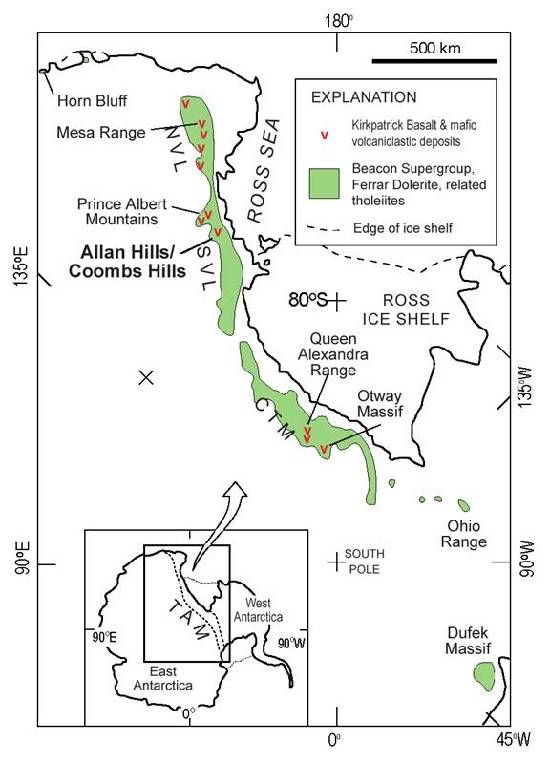
Figure 1: Map showing the distribution of the Beacon Supergroup, Ferrar Dolerite, and Kirkpatrick Basalt in the Transantarctic Mountains (TAM). Mafic volcaniclastic deposits, including the Mawson Formation, are found underlying the Kirkpatrick Basalt in North Victoria Land (NVL), South Victoria Land (SVL) and the Central Transantarctic Mountains (CTM). Redrawn after Hanson and Elliot (1996).
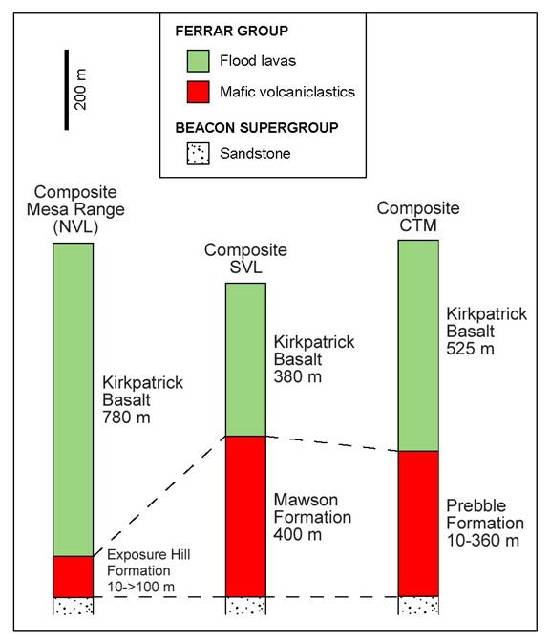
Figure 2: Summary stratigraphic sections showing flood lavas and mafic volcaniclastics of the Ferrar LIP (thicknesses after Elliot, 2000). Abbreviations as in Fig. 1.
The best and most extensive exposures of the Mawson Formation are at Coombs Hills and Allan Hills. At the former site, MVDs are interpreted to fill a large volcanic vent complex, also known as a ‘phreatocauldron’ (White and McClintock, 2001) because of the inferred phreatomagmatic fragmentation mechanism and the overall cauldron shape of the complex (Fig. 3). In other words, much of Coombs Hills represents a partly eroded volcano and we can have a look at the conduits through which explosive eruptions of the Ferrar LIP threw debris toward the paleo-surface. The conduits are preserved as cross-cutting volcaniclastic bodies in the vent complex (Ross and White, 2005a). The pipes filled with country rock-rich lapilli-tuff or tuff-breccia (Figs. 4, 5) are interpreted to have formed following phreatomagmatic explosions occurring near the walls or floor of the vent complex, causing fragmentation of both magma and abundant country rock material. In contrast, some of the cross-cutting zones filled with basalt-rich tuff-breccia or lapilli-tuff could have been generated following explosions taking place within pre-existing basalt-bearing debris, well away from the complex walls or floor. Other basalt-rich zones, accompanied by domains of in situ peperite and coherent basalt, are inferred to have originated by less violent processes.
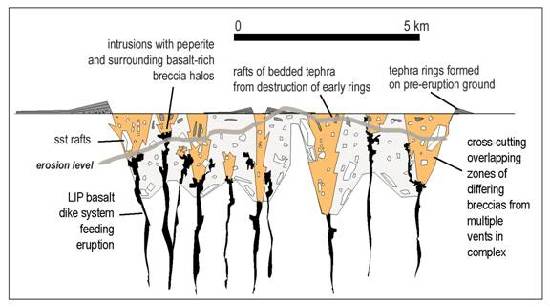
Figure 3: Schematic vertical section through the Coombs Hills vent complex, South Victoria Land, modified from White and McClintock (2001). The Jurassic cauldron-shaped complex is over 5 km across and consists of a series of coalesced diatreme-like vents, fed from mafic dikes (shown in black). The uppermost country rock (Triassic sandstones of the Beacon Supergroup) was poorly cemented/lithified in the Jurassic and represented a good aquifer. When magma reached this aquifer, phreatomagmatic explosions occurred and jets of debris (fragmented country rock, fragmented magma, recycled clasts) and fluids (magmatic gases, external water in vapour +/-liquid form) travelled upward inside transient conduits (Ross and White, 2005a). This was repeated over and over as magma kept coming up and water was in abundant supply. Rafts of soft country rock (shown in white) and layered volcaniclastic deposits (in grey) slumped into the vents.
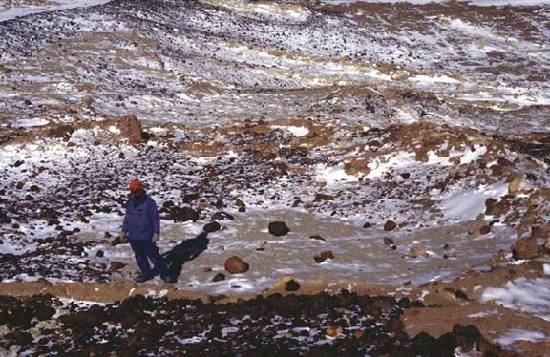
Figure 4: Outcrop aspect of a 10 m+ wide pipe filled with country rock-rich lapilli-tuff (depressed elliptical shape under standing person) inside the Mawson Formation at Coombs Hills.
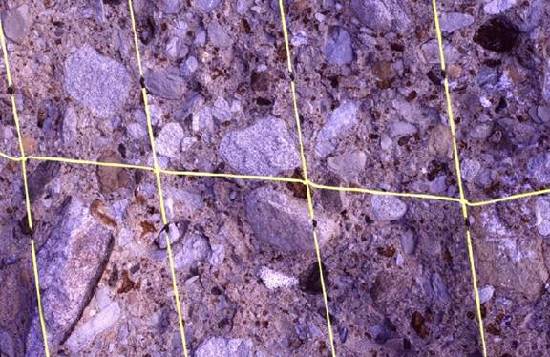
Figure 5: Detail of the country rock-rich material filling a pipe similar in shape to that shown in Fig. 4. Pale grey lapilli-grade clasts are sandstone, medium grey clasts are mudstone, and the brown ones represent juvenile basalt (formerly glassy) altered to palagonite and clays. The ash-grade matrix consists principally of (i) detrital quartz crystals (derived from disaggregation of quartz-rich sandstones from the country rock) and (ii) formerly glassy non-vesicular to poorly vesicular basaltic clasts.
Following the development of the vent complex at Coombs Hills, coarse unbedded MVDs were invaded by mafic plugs, some more than 150 m-wide (Fig. 6). These plugs could represent feeders to the lavas higher up in the sequence, as their diameters are more than sufficient to accommodate the inferred mass eruption rates for continental flood basalts and their chemistry matches that of the lavas (Ross, 2005). Both the plugs and the older MVDs were then cross-cut by volcaniclastic dikes up to 75 m-wide. Such clastic dikes are among the largest exposed anywhere on earth and we infer that the ash-grade material filling them was obtained by mobilization and sorting/filtering of the coarse vent-filling debris by fluidization above large basaltic intrusions (Ross and White, 2005b).
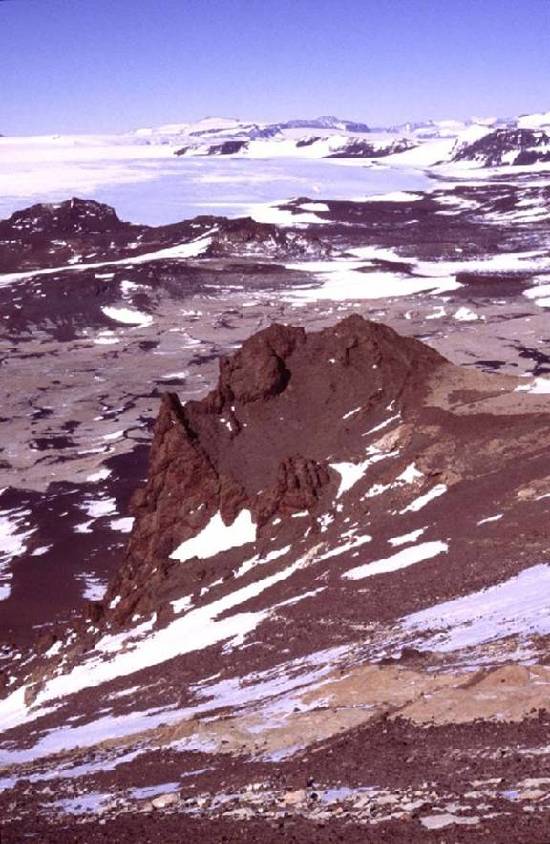
Figure 6: A 140 m-wide basalt ‘plug’ (prominent dark brown mass) invading the Mawson Formation volcaniclastic rocks (foreground) at Coombs Hills. Such basaltic plugs could have served as feeders to the Kirkpatrick flood lavas overlying the mafic volcaniclastic rocks. The flat outcrop area in the background is occupied by sedimentary rocks of the Beacon Supergroup, with large Ferrar intrusions on the left.
A few km away across a glacier at Allan Hills, the Mawson Formation can be divided into two members, m1 and m2 (Reubi et al., 2005). Member m1 is exposed only at central Allan Hills, consists essentially of sedimentary material from the underlying Beacon Supergroup, and is interpreted as a 180 m-thick debris avalanche deposit (see Reubi et al., 2005, for details – as far as we are aware, this is the first report of a debris avalanche deposit in a LIP setting). Member m2, which is exposed at both central and southern Allan Hills, consists predominantly of metre-thick mafic volcaniclastic layers that fall into three broad categories: (a) poorly sorted, coarse lapilli-tuff and tuff-breccia (Fig. 7); (b) block-rich layers (Fig. 8); (c) tuff and fine lapilli-tuff. The former type is interpreted as the deposits of high-concentration pyroclastic density currents, probably formed during the collapse of phreatomagmatic eruption plumes (Ross and White, 2005c). Occasional block-rich layers probably were formed by both ballistic fall from local vents and pyroclastic flows, and the finer-grained layers were probably deposited by dilute currents. Dilute, moist turbulent pyroclastic density currents were also likely responsible for the generation and deposition of large (≤4.5 cm) rim-type accretionary lapilli (Fig. 9). It is inferred that all these layers from the m2 member were deposited in a pre-existing topographic depression.
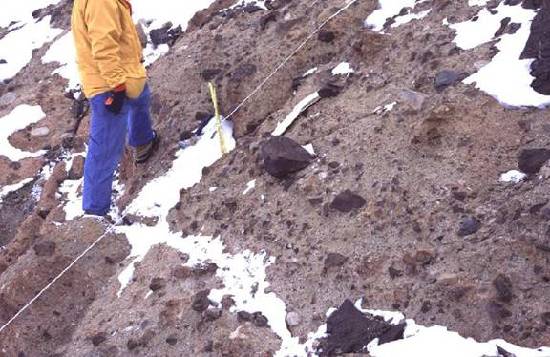
Figure 7: A mafic pyroclastic flow deposit in the Mawson Formation at southern Allan Hills. All the blocks on this picture are basaltic except three or four pale grey ones which consist of country rock-derived sandstone.
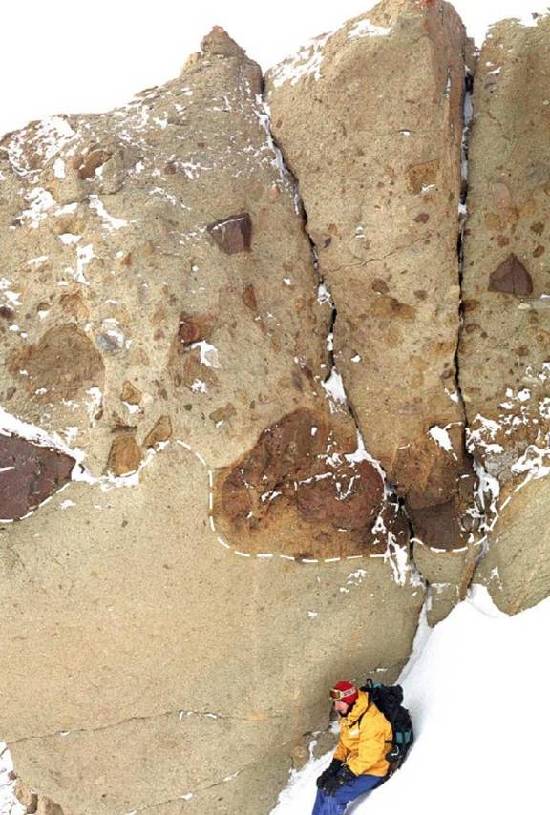
Figure 8: A normally graded block- and bomb-rich layer in the Mawson Formation at southern Allan Hills, showing an undulating base (dashed white line) because the largest bombs penetrated the underlying layer.
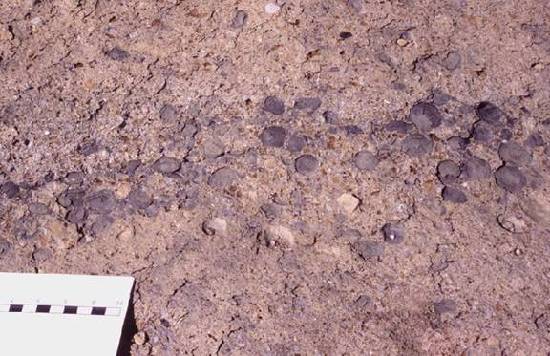
Figure 9: Accretionary lapilli-bearing volcaniclastic layer in the Mawson Formation at southern Allan Hills. This layer can be followed over perhaps a kilometre but varies greatly in thickness, probably because it was partly eroded by the pyroclastic density currents that arrived later. Scale bar is graduated in cm.
The presence of surface water is easily demonstrable at Carapace Nunatak, to the south of Allan Hills. There, sandstones correlated with the Mawson Formation were laid down on an alluvial plain (Ballance and Watters, 1971). Then, after deposition of finer grained lacustrine sediments and emplacement of a first lava (Bradshaw, 1987), a 40 m-thick unit comprising pillow lavas and pillow-palagonite breccias was formed (Fig. 10). The overlying lavas were likely subaerial, indicating the lake had dried-out or had been filled by coherent lava and fragmented lava at this stage.
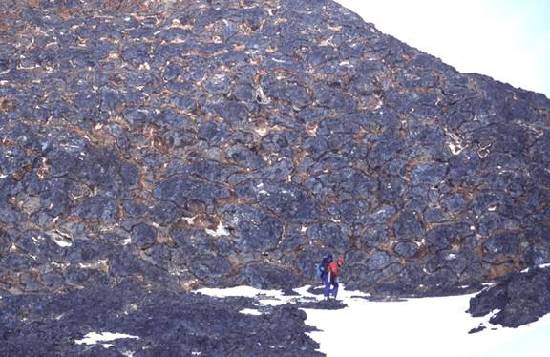
Figure 10: Pillow lavas emplaced in a Jurassic lake at Carapace Nunatak. These are part of a 40 m-thick unit that changes laterally to hyaloclastite and pillow breccias (Bradshaw, 1987).
In summary, MVDs of the Ferrar LIP predominantly consist of coarse lapilli-tuffs and tuff-breccias up to 400 m-thick which either fill self-generated composite holes-in-the-ground (phreatocauldrons) or pre-existing topographic depressions. They underlie the Kirkpatrick flood basalts throughout the Transantarctic Mountains and represent the phreatomagmatic precursors to flood volcanism. Surface water and groundwater played a major role in controlling the eruption styles. The potential for MVD-forming eruptions to generate significant environmental impacts (perhaps even causing mass extinctions) remains to be evaluated. As mentioned by Ross et al. (2005), apart from working on the physical volcanology of the MVDs to assess these potential impacts, one would also need to (1) acquire more data on the pre-eruptive volatile contents of the involved magmas; and (2) model eruption plumes for individual eruptions of known volume and dispersal, and in particular the height of release of volatiles in the atmosphere.
References
Ballance, P.F., and Watters, W.A., 1971, The Mawson Diamictite and the Carapace Sandstone, formations of the Ferrar Group at Allan Hills and Carapace Nunatak, Victoria Land, Antarctica. New Zealand Journal of Geology and Geophysics, v. 14, p. 512-527
Bradshaw, M.A., 1987, Additional field interpretation of the Jurassic sequence at Carapace Nunatak and Coombs Hills, south Victoria Land, Antarctica. New Zealand Journal of Geology and Geophysics, v. 30, p. 37-49
Eldholm, O., and Coffin, M.F., 2000, Large igneous provinces and plate tectonics. In: Richards, M.A., Gordon, R.G., and van der Hilst, R.D. (Eds.), The History and Dynamics of Global Plate Motions. American Geophysical Union, Geophysical Monograph 121, p. 309-326
Elliot, D.H., 1992, Jurassic magmatism and tectonism associated with Gondwanaland break-up: an Antarctic perspective. In: Storey, B.C, Alabaster, T. and Pankhurst, R.J. (Eds.), Magmatism and the Causes of Continental Break-up. Geological Society [London], Special Publication 68, p. 165-184
Elliot, D.H., 2000, Stratigraphy of Jurassic pyroclastic rocks in the Transantarctic Mountains. Journal of African Earth Sciences, v. 31, p. 77-89
Elliot, D.H., and Hanson, R.E., 2001, Origin of widespread, exceptionally thick basaltic phreatomagmatic tuff breccia in the Middle Jurassic Prebble and Mawson Formations, Antarctica. Journal of Volcanology and Geothermal Research, v. 111, p. 183-201 http://dx.doi.org/10.1016/S0377-0273(01)00226-8
Hanson, R.E., and Elliot, D.H., 1996, Rift-related Jurassic phreatomagmatism in the central Transantarctic Mountains: precursory stage to flood-basalt effusion. Bulletin of Volcanology, v. 58, p. 327-347
Reubi, O., Ross, P.-S., and White, J.D.L., 2005, Debris avalanche deposits associated with Large Igneous province volcanism: an example from the Mawson Formation, Central Allan Hills, Antarctica. Geological Society of America Bulletin, v. 117, p. 1615–1628 http://dx.doi.org/10.1130/B25766.1
Ross, P.-S., 2005, Volcanology of the Mawson Formation at Coombs and Allan Hills, South Victoria Land, Antarctica. PhD Thesis, University of Otago, Dunedin, New Zealand, 400 p.
Ross, P.-S., and White, J.D.L., 2005a, Debris jets in continental phreatomagmatic volcanoes: a field study of their subterranean deposits in the Coombs Hills vent complex, Antarctica. Journal of Volcanology and Geothermal Research, http://dx.doi.org/10.1016/j.jvolgeores.2005.06.007
Ross, P.-S., and White, J.D.L., 2005b, Unusually large clastic dykes formed by elutriation of a poorly sorted, coarser-grained source. Journal of the Geological Society [London], v. 162, p. 579-582 http://dx.doi.org/10.1016/j.jvolgeores.2005.02.003
Ross, P.-S., and White, J.D.L., 2005c, Mafic, large-volume, pyroclastic density current deposits from phreatomagmatic eruptions in the Ferrar large igneous province. Journal of Geology, v. 113, p. 627-649 http://www.journals.uchicago.edu/JG/journal/issues/v113n6/113061/113061.html
Ross, P.-S., Ukstins Peate, I., McClintock, M.K., Xu, Y.G., Skilling, I.P., White, J.D.L. and Houghton, B.F., 2005, Mafic volcaniclastic deposits in flood basalt provinces: a review. Journal of Volcanology and Geothermal Research, v. 145, p. 281-314 http://dx.doi.org/10.1016/j.jvolgeores.2005.02.003
White, J.D.L., and McClintock, M.K., 2001, Immense vent complex marks flood-basalt eruption in a wet, failed rift: Coombs Hills, Antarctica. Geology [Boulder], v. 29, p. 935-938 http://dx.doi.org/10.1130/0091-7613(2001)029<0935:IVCMFB>2.0.CO;2